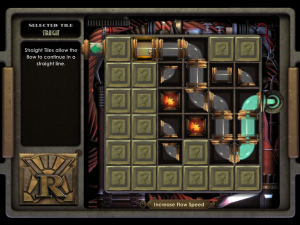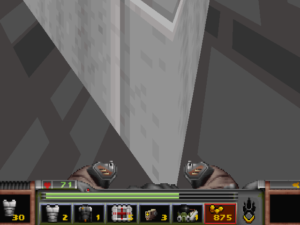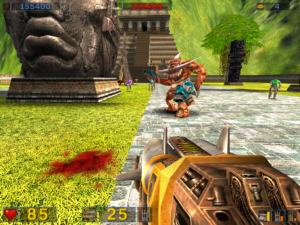Deus Ex: Ladders
Let’s talk about this game’s treatment of ladders because I’ve been dealing with them a lot lately. They’re kind of a fascinating snapshot of a moment in the history of the medium. The whole idea of a ladder here is that it’s a segment of wall, usually with its own special texture, that keeps you from falling when you’re touching it and which lets you move freely up or down, or really in whatever direction you’re facing. Note what this lacks that nearly any 3D game containing ladders would have nowadays: any notion of “locking on” to the ladder and constraining your movement to it until you do something to explicitly let go. That and the complete 3D freedom of movement mean that if you’re not completely square with the wall, you can easily go veering off to the side and fall. It’s especially easy to slip up this way when parts of the ladder are in darkness, which they very often are in this game’s eternal nighttime. And then there’s the perilous matter of mounting ladders from the top, a skill I still haven’t mastered. Do it wrong and you simply fall the full height of the thing. There’s a factoid (made famous by a Gravity Falls quotation) that having a ladder in your house is more likely to result in injury than having a gun in your house. While I don’t think my deaths from ladders in this game outnumber by deaths from guns, I’m not entirely sure of it.
Why does the game do it this way? Well, in part it’s because best practices for handling ladders weren’t well-established yet when it was made. Indeed, they’re not consistently followed even in games released long afterward; I’m told that GTA5 (2008) has notoriously dodgy ladders. They’re simply a nontrivial thing to get right. Moreover, though, this is a game in the design lineage of System Shock, which had similar issues. And in System Shock, it was the result of a design philosophy. Although it didn’t really wind up this way, part of the initial idea behind System Shock was to be “Sonic the Hedgehog in 3D” (at a time when Sonic itself wasn’t), a game of flowing kineticism produced by simulated physics as a coherent unit, with special cases and special interactions kept to a minimum. The idea of a ladder as a sort of short-range gravity-nullification field fit into that design philosophy perfectly. Deus Ex is even less of a Sonic-like than System Shock ever was: the stealth mechanics mean you spend more time crouching and waiting than running and jumping. But the physics remain.
 Comments(1)
Comments(1)


